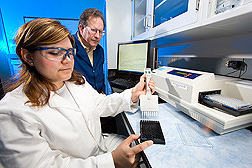Like Malt? You’ll Love This
Malting Barley Research!
|
|
If you’ve always thought that snacking on those little chocolate malt candies at the movies is half the fun of going to the theater, read on!
You’ll be glad to know that malting barleys—the ones used for making malt for breakfast cereals, candies, beer, and other favorite foods and beverages—are the focus of research by two ARS experts at Madison, Wisconsin. Chemist Mark Schmitt and plant physiologist Allen Budde, with the agency’s Cereal Crops Research Unit, are discovering more about what goes on inside little barley kernels germinating in the malt house. It’s those kernels that give us the smooth, delicious flavors of malt.
Findings from the scientists’ basic and applied research help plant breeders develop even better malting barleys for tomorrow. Of particular interest to Schmitt are the enzymes the kernel creates while it is sprouting. These specialized enzymes, for example, disassemble stored proteins into their component amino acids and convert stored carbohydrates into molecules called “simple sugars.”
Schmitt is also interested in the balance of this protein-carbohydrate breakdown. Why the interest? Because the balance can affect malt’s flavor and other attributes.
In a 2008 issue of the Journal of Cereal Science, Schmitt documented a study that not only provided new insight into the interplay of the enzymes, but also led to follow-up studies in progress at his lab today. In the published research, Schmitt worked with protein-degrading enzymes known as “serine-class proteases.” He found that they can degrade another enzyme, beta-amylase, a key player that degrades carbohydrates. The finding is notable because it showed, for the first time, that a protein-degrading enzyme in a grain kernel can digest an important, carbohydrate-degrading enzyme.
Hints of an interesting interaction between serine-class proteases and beta-amylase began to emerge in a study Schmitt reported in 2007 in the journal Cereal Chemistry. In that survey of more than 2,000 North American malting barleys, Schmitt and Budde found an unexpected correlation between high levels of a desirable beta-amylase-associated attribute and low levels of serine-class proteases. The later discovery that serine class proteases can digest beta-amylase offers a possible explanation for this inverse correlation.
“This all goes to show that we have a lot more to learn about the subtle interplay of the barley kernel enzymes during germination in the malt house and how the activity and balance of the enzymes affects the quality of the malt,” Schmitt says.
It’s research that should help barley breeders everywhere stay steadily on track in their quest to produce malting barleys that are superior even to today’s very best.
For us malted milk fans, that’s good news, indeed.—By Marcia Wood, Agricultural Research Service Information Staff.
This research is part of Quality and Utilization of Agricultural Products, an ARS national program (#306) described at www.nps.ars.usda.gov.
Mark Schmitt and Allen Budde are in the USDA-ARS Cereal Crops Research Unit, 502 Walnut St., Madison, WI 53726; (608) 262-4480 (Schmitt), (608) 262-4483 (Budde).
"Like Malt? You’ll Love This Malting Barley Research!" was published in the February 2010 issue of Agricultural Research magazine.







